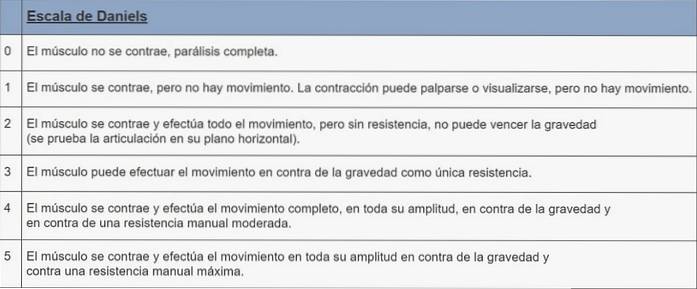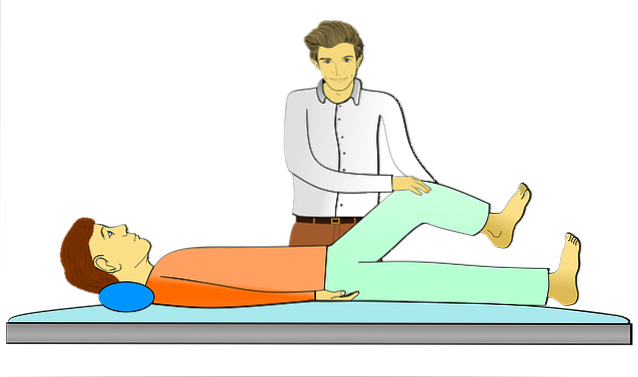
Daniels scale what evaluates, description, criteria

The Daniels scale is a scale used to measure the strength of muscles in the human body, especially in physiotherapy patients. It consists of evaluating muscle contraction against certain requirements, giving it values between 0 and 5.
This scale was published for the first time in 1946 as part of the first medical text referring to muscle evaluation techniques, which was written by Americans Lucille Daniels, Marian Williams and Catherine Worthingham and is still valid today. The title of the work was and still is today: Functional Muscle Testing: Manual Examination Techniques.

The contribution of the aforementioned authors and their predecessors was very significant for the field of physiotherapy, as this scale is truly useful for evaluating the muscle performance of patients who have suffered some type of muscle or nerve injury, and even patients with neuromuscular diseases congenital or acquired.
The main function of this scale and, therefore, of the test that is carried out to record its values for muscle performance, consists in locating lesions, either at the level of the central or peripheral nervous system, or at the local level in a specific muscle group, particularly in the joints.
Article index
- 1 What does the Daniels scale assess?
- 1.1 Numerical score
- 1.2 Qualitative score
- 2 Degrees of the Daniels scale
- 3 Modified Daniels scale
- 4 Differences with the Lovett scale
- 5 References
What does the Daniels scale assess?

The Daniels scale is used to evaluate the muscle contraction of an isolated muscle or of the muscles related to the joints, which are those that allow joint movement.
Remember that joints are the junction sites between two or more bones; They are generally mobile and are made up of tissues that provide elasticity and stability, such as cartilage, ligaments, tendons, synovial fluid, etc..
The 6-degree system on which the Daniels scale is based is ideal for determining both the strength and the function of the muscles, especially in patients who have suffered specific injuries to a motor nerve, in the spinal cord, in the brain , in peripheral nerves or in some specific muscle tissue.
Numerical score
The scale allows the expression of a numerical score ranging from 0 to 5 to assess muscle performance through a manual test, which is generally performed by a healthcare professional.
The lowest value (0) implies absence of activity, while the highest (5) represents a normal response in terms of joint contraction and movement..
Qualitative score
In addition to the numerical score, this scale includes an evaluation or qualitative score that goes from normal (N) to null (no activity, 0), which is established thanks to the performance of different physical tests, including:
- Break test: where manual resistance is applied to the muscle group being evaluated and the ability of the muscle to contract against said resistance is determined (which usually implies that the therapist seeks to “break” the maintenance of the contraction)
- Active resistance test: where a manual resistance is applied against the muscle group that is in active contraction, that is, against the direction of movement.
Daniels scale grades
The 6 degrees of the scale are as follows:
- 0 = absence of activity or contraction, which translates as total paralysis.
- 1 = visible contraction, but no evidence of significant movement (in some texts it is described as "flickering" of the muscle).
- 2 = there is contraction and the muscle group can achieve joint movement in its full range, but not against gravity.
- 3 = the muscle can complete the full range of motion, but only by resisting the force of gravity; when resistance is applied the movement stops.
- 4 = the muscle can complete the full range of motion and tolerate moderate resistance without interrupting it, although applying maximum resistance shows a clear "break" in motion.
- 5 = this is "normal force" and the examiner or therapist cannot change the final position of the contracted muscle at the end of the test range and with maximum resistance.
The qualitative evaluation assigns the parameters normal (N), good (B), fair (R), poor (D), traces of activity (V) and null (no activity, 0) to the values 5, 4, 3, 2 , 1 and 0, respectively.
Modified Daniels scale
Although it is a somewhat ambiguous topic, the medical research council (Medical Research Council) proposes modifying the Daniels scale with the addition of some +/- values of those previously established.
Thus, the scale includes the following quantitative parameters:
- 0 = total paralysis or complete absence of movement
- 1 = minimal visible shrinkage, but no movement
- 2 = little contraction, with movement, but nonexistent when resistance is applied (cannot occur against gravity)
- 3- = negative regular contraction, where partial movement occurs, although gradual release from test position is observed
- 3 = regular contraction, where a partial movement occurs with the force of gravity as the only resistance
- 3 + = positive regular contraction, where full motion occurs, but only against gravity
- 4- = good negative or regular shrinkage, where full motion occurs against gravity and with the application of minimal resistance
- 4 = good contraction, with full motion against the force of gravity and application of moderate resistance
- 4 + = positive good shrinkage, where full motion occurs against the force of gravity and with the application of strong resistance
- 5 = normal contraction, where the complete movement occurs against gravity and maximum resistance
Differences with the Lovett scale
The scales for measuring muscle activity or strength are very similar to each other. Although the Daniels scale is the one most used today by physiotherapists, it may also be the case that other closely related ones are used interchangeably.
Such is the case of the Lovett scale, proposed by Wilhelmine Wright and Robert W. Lovett, who were the pioneers in the creation of the muscle testing system incorporating the effect of gravity, around the 1910s..
In the original publications, Lovett described tests performed on pediatric patients with polio-related paralysis, whose muscles were tested using a resistance-gravity system graded on a scale of 0 to 6.
Although it adds an additional value to the rating range, the scale is basically the same as established in the texts by Daniels, Williams and Worthingham (today known only as Daniels and Worthingham).
References
- Avers, D., & Brown, M. (2018). Daniels and Worthingham's Muscle Testing, First South Asia Edition EBook: Techniques of Manual Examination and Performance Testing. Elsevier.
- Hislop, H. J., & Montgomery, J. (1996). Techniques of Manual Examination.
- Medical Research Council of the UK. (1976). Aids to the investigation of Peripheral Nerve Injuries, Memorandum No. 45.
- Peterson-Kendall, F., Kendall-McCreary, E., Geise-Provance, P., McIntyre-Rodgers, M., & Romani, W. (2005). Muscles testing and function with posture and pain. US: Lippincott Williams & Wilkins Ltd, 49-118.
- Tweedy, S. M., Williams, G., & Bourke, J. (2010). Selecting and modifying methods of manual muscle testing for classification in Paralympic sport. European Journal of Adapted Physical Activity, 3 (2), 7-16.



Yet No Comments